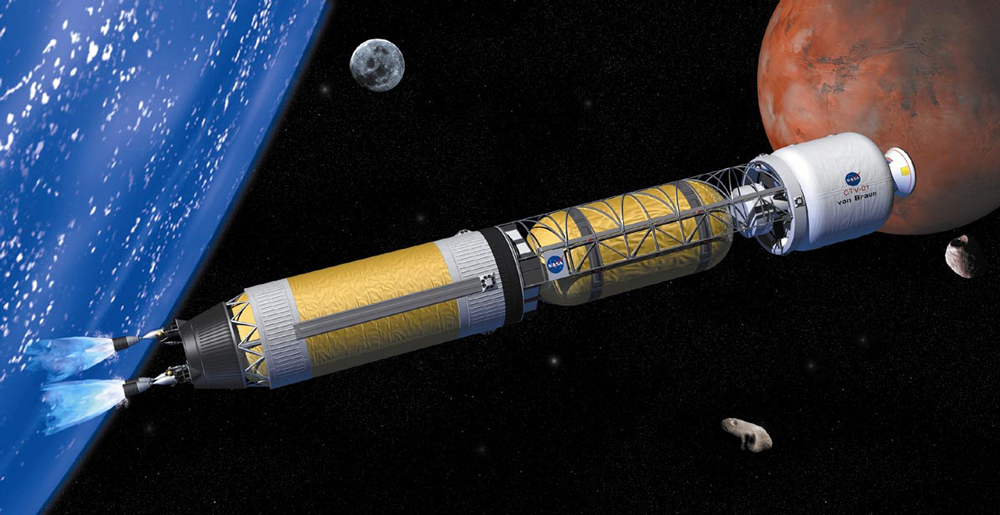
CANOGA PARK, Calif. — Getting astronauts to Mars will take all the spacefaring expertise the United States can muster, including advanced propulsion technologies such as solar-electric engines and perhaps even nuclear rockets, according to NASA Administrator Charlie Bolden.
In statements made during a visit to the Aerojet Rocketdyne plant here last Thursday (May 28), Bolden stressed that he'd like to slash the travel time required to send astronauts to Mars.
"Right now it's about an eight-month mission; we'd like to cut that in half," Bolden told reporters after speaking to Aerojet Rocketdyne workers for 30 minutes or so. [Superfast Propulsion Concepts (Images)]
Superfast propulsion tech would help limit astronauts' radiation exposure during the trek to Mars and reduce the amount of water, food and other "consumables" such a mission would require, NASA officials have said.
Bolden was flanked by Aerojet Rocketdyne's CEO and president Scott Seymour and Julie Van Kleeck, the company's Vice President of Advanced Space & Launch Systems, during the news conference. The trio discussed the advanced solar-electric propulsion systems (SEP) the company has been working on.
"We're now trying to get to higher power levels; that's the next step," Seymour said, referring to the 5-kilowatt (kW) engines Aerojet Rocketdyne is currently building for NASA robotic missions. "Fifteen kilowatts would be the next step, and then to cluster them together ... then, in the long term, 50 to 100 kilowatts."
"The limiting power of this type of propulsion has been the power to drive it," Bolden said. "Aerojet Rocketdyne has partnered with different entities around the country in looking [at] how to get more energy density onto a solar cell. The more power we can get, the larger we can make the engine and its capability.
Get the Space.com Newsletter
Breaking space news, the latest updates on rocket launches, skywatching events and more!
"The advantage of using that kind of propulsion, pound for pound, is that it can fly nearly forever as opposed to chemical engines," Bolden added, in reference to the traditional liquid-fueled rocket engines that propel the vast majority of NASA's spacecraft.
But these SEP units — which generate thrust by accelerating charged atoms and molecules out the back of a spacecraft — are limited in what they can accomplish. Discussing more advanced in-space propulsion, Van Kleeck referred back to nuclear rockets, such as the NERVA (Nuclear Engine for Rocket Vehicle Performance) system studied by NASA decades ago.
"This country did a lot of work on that back in the 1960s and 1970s, and there is some technology being looked at regarding the fuels aspects of that, to make it lower cost and safer for the future," Van Kleeck said. (NERVA was scrapped in 1972, despite successful ground-firing tests and promising performance.)
"We don't build rocket engines; we depend on our industry partners. " Bolden said. "My job is to try and keep things stable for them, to let them know that we are committed to in-space propulsion."
Bolden said that he wanted to put more money into these advanced space-only systems, which could potentially be "game changers" — and not just for delivering cargo to Mars.
"You've got to be specific," Bolden said. "If I say I want game-changing in-space propulsion, everyone will go back to [the idea of] moving cargo. I want industry to focus on getting peopleto move really fast. I think we can do far better than we are doing today, but we've got to show our commitment by putting some money into it."
Follow us @Spacedotcom, Facebook or Google+. Originally published on Space.com.
Join our Space Forums to keep talking space on the latest missions, night sky and more! And if you have a news tip, correction or comment, let us know at: community@space.com.

Rod Pyle is an author, journalist, television producer and editor in chief of Ad Astra magazine for the National Space Society. He has written 18 books on space history, exploration and development, including "Space 2.0," "First on the Moon" and "Innovation the NASA Way." He has written for NASA’s Jet Propulsion Laboratory, Caltech, WIRED, Popular Science, Space.com, Live Science, the World Economic Forum and the Library of Congress. Rod co-authored the "Apollo Leadership Experience" for NASA's Johnson Space Center and has produced, directed and written for The History Channel, Discovery Networks and Disney.